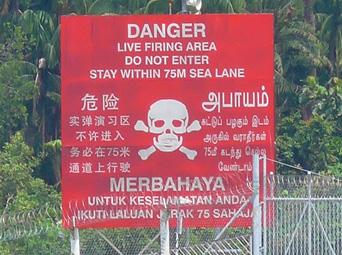| |


|
|
|
 |
Day 4,148 - Puteri, Malaysia
11:52hrs - October 8, 2018
Ship or Sail? - Part 1 (Gathering Data) |

After nine years of drifting peacefully between friendly South Pacific isles, enjoying warm receptions along safe shores and, besides the occasional outburst from Mother Nature, quiet uneventful passages, we've crossed the equator, returned to the northern hemisphere and begun a complicated new chapter of Dream Time's circumnavigation.
We're now sailing up the busy western coast of Malaysia along the infamous Malacca Straits, a congested and notorious waterway that boasts the world's highest concentration of piracy attacks. Tens of thousands of tug boats, tankers and containerships hauling 30% of global trade - five trillion dollars worth of goods - transit the region each year. But thankfully, for cruisers at least, pirates only seem interested in swinging their grappling hooks in the direction of these commercial vessels, leaving tiny sail boats of Dream Time's description, hauling nothing more valuable than a few months supply of cheese, to slip through unmolested.
But in a few months we'll be approaching a major crossroads on our voyage. Just four hundred miles to the north lays Thailand and in the New Year we'll face our most difficult cruising decision since setting sail from New York in 2007: Do we ship, or do we sail Dream Time into the Mediterranean Sea?
A Brief History:
Traditional sailing routes from Asia to the Mediterranean carry mariners across the Indian Ocean and into the Gulf of Aden, through the Bab el Mandeb, or Gates of Sorrow - the narrow southern entrance to the Red Sea - then north to Egypt. It's a passage I completed in 1994 when I sailed from Sydney to Italy via Christmas Island, Cocos Keeling, Chagos, Seychelles, around the Horn of Africa to Djibouti, and finally through the Suez Canal to Rome. And while piracy around the Horn of Africa in 1994 was a concern and Australian officials warned us to remain a few hundred miles off the infamous coastline, twenty-four years ago the threat of attack or a hostage situation was such a remote possibility it fell within an acceptable risk range, one similar to striking a semi-submerged cargo container, for example, colliding with a snoozing humpback whale at night, or weathering a severe storm at sea. And so we sailed past Somalia and through the Gulf of Aden without incident.
But over the last fifteen years Somalia experienced civil war, famine, illegal fishing and the illegal dumping of industrial waste along its coastline, disrupting the local fishing industry and driving some fishermen to seek compensation elsewhere. And what began as attacks by Somali fishermen against illegal fishermen in an attempt to protect their waters and livlihoods, escalated to organized criminal activity and the rapid increase of piracy around the Horn of Africa. Motherships now venture further from shore to catch their prey who, during hostage negotiations, have be held for months, even years, while demands were settled. Equipped with machine guns, RPGs and high-speed boats, Somali pirates in 2010, their most active and profitable year, hijacked forty-nine vessels and made an estimated $238 million in ransom payments.
Increased Security:
But to improve security to commercial shipping in the region, Combined Maritime Forces, a naval coalition of thirty-three countries, now patrol these troubled waters and along with efforts to address the root cause of piracy, attacks around the Horn of Africa and the Gulf of Aden have been in decline. 2016 reporting only 27 reported attempts and zero hijackings.
Some authorities attribute the lower number of attacks not only to the CMF, but to defensive measures taken by merchant vessels to help ensure a safe transit, including; contracting armed security guards, installing high-pressure water hoses on decks, razor wire, sonic weapons, mannequins to give the appearance of higher crew numbers, and by transiting inside the Maritime Security Transit Corridor - a military established channel of water across the Gulf of Aden where naval vessels concentrate their surveillance efforts. Additionally, with fewer sailboats in the region, there has been a significant reduction of soft-targets for pirates to focus their attacks.
Sailing Statistics:
Before the year 2000, two hundred cruising sailboats transited north from the Indian Ocean, up the Red Sea and into the Mediterranean each year, almost twice the number than those choosing to sail the less favorable route around South Africa. Yet by 2015, due to the risk of piracy in the Gulf of Aden, the numbers were dramatically reversed with 358 yachts sailing the longer South African route and just fourteen yachts sailing into the Gulf of Aden and north up the Red Sea. It's interesting to note that during the same year, twenty-five yachts chose to ship their vessels through the Red Sea rather than sail.
We are currently undecided whether to ship or sail Dream Time into the Mediterranean Sea and will gather more information before making our decision. To decide we will weigh the potential costs of sailing versus the actual costs of shipping. Risks aside, we would rather sail.
One thing is certain, we miss the carefree cruising of the South Pacific. |